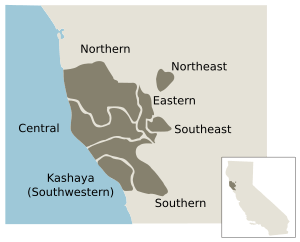Northern Pomo language facts for kids
Quick facts for kids Northern Pomo |
|
|---|---|
| Native to | United States |
| Region | Northern California |
| Native speakers | 1 (2007)e19 |
| Language family |
Pomoan
|

The seven Pomoan languages with an indication of their pre-contact distribution within California
|
|
Northern Pomo is a language spoken by the Pomo people, who are Native Americans from what is now California. Sadly, it is a language that is almost gone, with very few speakers left. The Pomo people who traditionally spoke Northern Pomo lived in the biggest and most northern part of the Pomoan lands. Other groups living nearby were the Coast Yuki, the Huchnom, and the Athabascan speakers. To help keep the language alive, Ukiah High School started teaching Northern Pomo in the fall of 2020.
Contents
What is Northern Pomo?
Northern Pomo is part of a larger group of languages called the Pomoan language family. Think of a language family like your own family tree, with different branches. Northern Pomo belongs to the "Western" branch of this family. It's special because it's the only language in this Western branch that isn't part of the "Southern" group.
A Look Back: History of the Language
The first time anyone wrote about Native Americans in this area was in 1579, by General Drake. However, we can't be sure if these were the Pomo people. Later, in 1851, Colonel Redick M'Kee took a count of the people during an expedition. He estimated there were about 1,000 to 1,200 Pomo people. But neither of these early explorers wrote down anything about the language itself.
It wasn't until later expeditions that the Pomoan language family started to be recorded. John Wesley Powell made notes about the languages in 1891, and Samuel Barrett followed up with more information in 1908. These records helped us learn about the different branches of the Pomoan language family.
Where Northern Pomo Was Spoken
Northern Pomo was spoken in the northern coastal part of California, in the United States. The Pomo people lived in a very large area. This land stretched north of the San Francisco Bay and surrounded Clear Lake in northern California. According to a 2010 count, there are over 10,000 Pomo people in the United States, with most of them living in California.
Other Pomoan Languages
The Pomoan language family has seven different languages. Northern Pomo is just one of them! Here are all seven:
- Northern Pomo
- Northeastern Pomo
- Eastern Pomo
- Central Pomo
- Southern Pomo
- Southeastern Pomo
- Kashaya (Southwestern) Pomo
How Northern Pomo Works: Grammar Basics
Talking About Family and People
In Northern Pomo, people often avoid using someone's first name when they are talking. Instead, they use words that show how people are related, like "father," "mother," or "sister." This is especially true if a family member has passed away. Because of this, speakers often use third-person words (like "he," "she," or "they") when talking about people.
If a close family member has died, speakers will not say their name. They won't even say the name if a living relative has the same name. People talking to them are also expected to avoid saying these names. This is seen as a way to show respect for the person who passed away and their relationship with the speaker. However, people who are not as close to the family might sometimes mention the names of those who have died.
Showing What Belongs to Whom
Northern Pomo has different ways to show who owns something or who something belongs to. It can switch between a normal way of showing possession and a special way called "possessor raising."
In a normal sentence about owning something, the main focus is on the person who owns it. But with "possessor raising," the focus shifts to the object or person being owned. For example, if you're talking about someone's hand, using "possessor raising" might mean you're focusing on the hand itself and what might happen to it, or a special feature it has. This can change the meaning of a sentence, especially when talking about body parts or traits that might have consequences.

